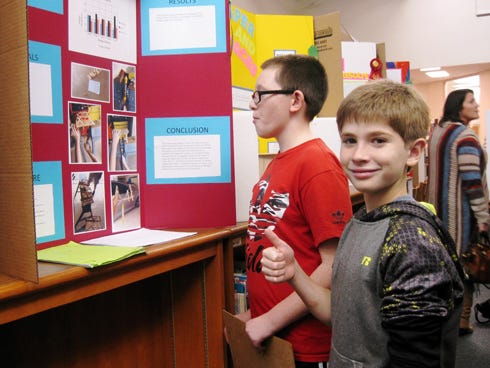
CRESTVIEW — Nineteen Davidson Middle School students have qualified for the Feb. 3 regional science fair at the Northwest Florida Fairgrounds in Fort Walton Beach.
They are: Cadis Ammons, Teresa Baltimore, Lauren Clark, Austin Dickson, Arlennyz Difo, Amber Etheridge, Elizabeth Everett, Nathaniel Ferrell, Aiden Finney, Kilee Hampton, Ian Hatten, Kelsey Jacobson, Jae Kim, Jaemo Kim, Hunter Kronmiller, Halle Mynard, Madison Parker, Tavee Thyse and Emily Wayer.
The finalists, and about 140 of their fellow sixth-, seventh- and eighth-graders asked a lot of questions, ran experiments to test their hypotheses, and supported or disproved their assumptions during DMS's recent science fair.
DMS science fair first-place winners were:
●Animal Sciences: Cadis Ammons
●Chemistry/Biology: Kilee Hampton
●Earth and Environmental Science: Elizabeth Everett
●Environmental Engineering: Emily Wayer
●Electrical/Mechanical Engineering: Austin Dickson and Aiden Finney (tie)
●Materials/Bioengineering: Jae Kim
●Robotics/Software: Nathaniel Ferrell
●Microbiology: Amber Etheridge
●Physics and Astronomy: Jaemo Kim and Madison Parker (tie)
●Plant Sciences: Halle Mynard
Each student's project — exhibited Dec. 10 in the school's Media Center — reflected efforts to analyze his or her world, Davidson science teachers said.
“Our criteria is it has to help society,” science teacher Sharon Richardson said.
University of Florida faculty and professional engineers, who served as judges, reviewed students' displays, records and notebooks, and conducted face-to-face interviews with the kids.
Emily Wayer’s first-place-winning “It’s a Little Corny” tested whether pond water in an impoverished community, when filtered through cornhusk and corn silk, could be rendered safe to drink.
Though experimentation didn't support Emily’s hypothesis — the water actually became acidic — that didn’t deter her from a goal she's had since visiting Swaziland with her family during a mission trip to supply drinkable water to poor villages. “It is my dream to bring clean drinking water to impoverished communities around the world,” she wrote in her purpose statement.
Jenna Cyrus won a second-place ribbon for “Cookie Confusion,” her experiments on different baking sheets. “I wanted to see what type of cookie sheet will prevent cookies from being very burnt,” she said, adding the best part of the project was “doing the experiments and making the board.”
Tristan Dees tested the pH of Coke, Dr. Pepper, Cheerwine and ginger ale to see which soft drink was less harmful to his teeth. Cheerwine was marginally less harmful.
Outdoors-oriented students like Haley Durran, Tavee Thyse and Drew Barefield, observed the moon’s effect on deer activity, coyotes, and when wild turkeys tend to be most active.
Aleigh King determined that, of vanilla, chocolate and chocolate chip ice cream, chocolate melts the fastest, rejecting her hypothesis that the chocolate chip mint would be the first to melt.
It took almost 1,800 popsicle sticks to confirm, but sixth-grader Trace Carney disproved his hypothesis — that a suspension bridge would hold the most weight.
After recording and photographing the effect of adding weight to suspension, truss and cantilever bridges, he found the truss structure carried the most load.
“We made 15 bridges to test,” his mom, Kara Adams, said.


This article originally appeared on Crestview News Bulletin: 19 Davidson Middle School students advance to regional science fair
